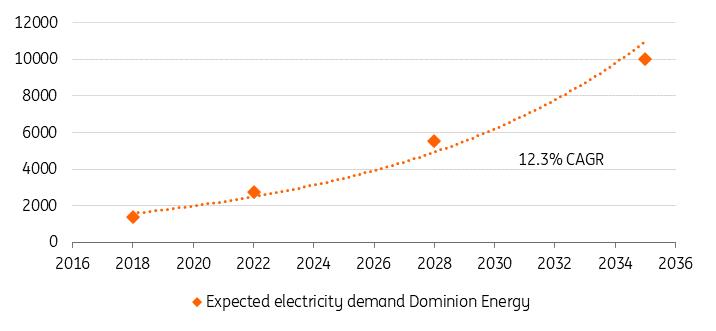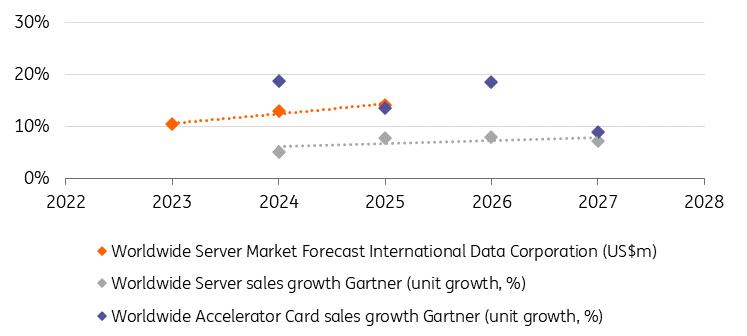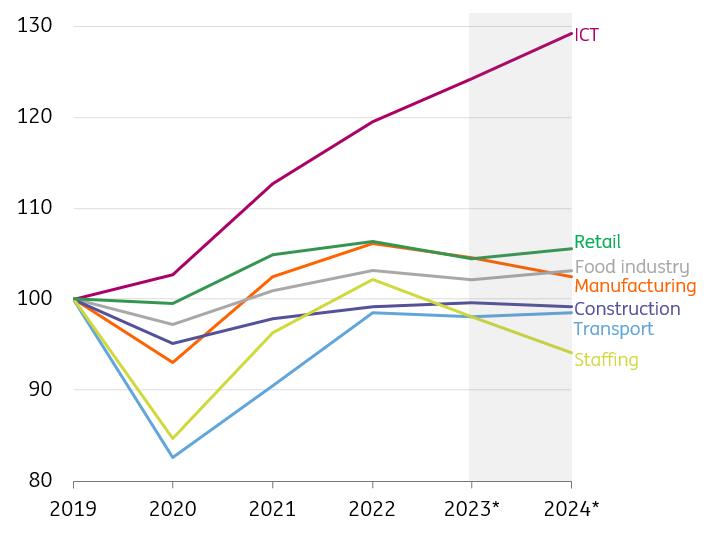(MENAFN- ING)
We expect the ICT sector to exhibit strong growth on the back of the development of Generative AI services. Nevertheless, our expected growth figures are somewhat below numbers from Generative AI advocates. However, strong growth from Generative AI will result in substantial electricity demand, fuelling a debate on the desirability of further data centre investments in some countries. As we have shown in previous article , the data centre sector and Generative AI will be an important factor in enhancing productivity, while the ICT sector shows above-average growth rates. Therefore, we argue that countries should not miss out on this growing sector.
Industry veterans forecast extreme growth
In February 2024, Sam Altman the CEO of OpenAI posted on X:
According to the WSJ, he has pitched a plan to develop his own semiconductor foundries to meet the global demand for AI microchips with an investment need of US$7 trillion. That view has been contested by Jensen Huang of Nvidia, who thinks the investment needs are overstated because of advances in semiconductor speeds as well as the development of more efficient AI models. According to Bloomberg, Huang expects that the current installed AI data centre capacity is worth US$1tn, which probably has to double to US$2tn in five years' time.
Are investments of up to US$7tn across the value chain really needed? We will evaluate the different segments of the value chain to put this amount into perspective and present our view on future investments.
Utilities expect strong electricity demand from data centres
Dominion Energy plans for strong electricity demand growth in North Virginia

Source: Datacentrefrontier, Dominion Energy, ING When evaluating the capital investments by the four large operators of hyperscale data centres, one finds a compound annual growth rate of 11% between 2021 and 2025 (the last year being based on consensus expectations).
Another growth figure is provided by the expected electricity demand in Virginia (USA), which is home to an agglomeration of data centres. Dominion Energy, the largest utility in Virginia, expects that the electricity demand in the area will grow by 12.3% until 2035. Although this figure is contested by some, it matches the recent growth rate in investment.
Semiconductor demand is expected to show strong growth rates
Strong semiconductor demand shows sector electricity demand will increase

Source: International Data Corporation, Gartner, ING We think investments in semiconductors point to strong 10% growth
However, when we study the sales of server microchips (CPUs), growth rates are lower. Gartner expects that the worldwide sales of semiconductors will grow by a high single-digit figure, as can be seen in the graph below. Nevertheless, besides the demand for server microchips, data centres will also employ more accelerator cards. Gartner expects a higher growth rate for these accelerator cards (GPUs) than for the server microchips (CPUs). This is in line with our thinking, as companies will rely on the accelerator card for the training and use of Generative AI models. When taking all growth figures into account, we expect the energy consumption of data centres to grow by c.10% in the coming years, although this is a figure surrounded by much uncertainty, because it also implies that the compute instances grow much faster (because chips become more efficient).
To come back to the debate between Jensen Huang and Sam Altman, we do believe that the sector will witness strong growth but expect it to take a bit more time to reach these figures, as investments will be more moderate in the near term.
The expected growth rate in energy consumption by c.10% reflects an increase from our previous research. In earlier research , we evaluated energy efficiency in the sector (resulting from the scale efficiencies of data centres and Moore's Law), as well as the need to use green electricity. We showed that it is tricky to only focus on the growing electricity demand of the data centre sector because this data does not incorporate a potential reduction in energy use in other sectors.
Nevertheless, it is clear that low energy prices offer a comparative advantage for the industry since energy is an important input for data centres. Besides a favourable climate and good data connections, this will be an important factor driving the attractiveness of investment locations. Moreover, we expect data centres to exhibit a desire to procure green energy and nuclear energy, because the companies and their clients sometimes have to report the CO2 emissions from their suppliers. We discussed the procurement of green energy and sustainable finance in an earlier article .
The ICT sector expected to show continued above average growth
Development production (volume value added) EU sectors (Index 2018=100)

Source: Eurostat, ING Research (* 2023 Estimate & 2024 Forecast) The ICT sector will continue to show above average growth rates as well
Because AI-related services will likely be implemented across the economy, the Information and Communication Technology sector has the scope to grow volumes faster than the overall economy, as it did in previous years. If companies see an opportunity to lower their cost base through the use of AI services, this increases the total addressable market for the ICT market. Previously, a large part of the advertising market was replaced by digital solutions. A similar development can be seen in the linear TV market, which is developing into a streaming video model. The developments around chatbots, translation tools and the many other AI-based services imply that the technology sector has a revenue opportunity, although these services will be an expense item for other companies. We expect that the overall ICT sector will show an above-average growth rate in the mid-single digit area over the coming five years, at least.
We need to invest in AI data centres because of labour market challenges and the need for technological sovereignty
We have shown in recent articles that AI will have a positive impact on labour productivity and will change the tasks employees will perform. We would argue that it is better for countries to embrace this change and try to get a fair share of the newly emerging business opportunities. Having access to this technology improves technological sovereignty. Of course, the environmental impact of new investments should be considered, as we have shown in our article on sustainable finance principles. However, as the required investment scale is a challenge in itself, we should better take on the tasks and try to build data centres for AI when opportunities are there.
MENAFN24042024000222011065ID1108134356
Author:
Jan Frederik Slijkerman
*Content Disclaimer:
This publication has been prepared by ING solely for information purposes irrespective of a particular user's means, financial situation or investment objectives. The information does not constitute investment recommendation, and nor is it investment, legal or tax advice or an offer or solicitation to purchase or sell any financial instrument. Read more here: https://think.ing.com/about/disclaimer/
Legal Disclaimer:
MENAFN provides the information “as is” without warranty of any kind. We do not accept any responsibility or liability for the accuracy, content, images, videos, licenses, completeness, legality, or reliability of the information contained in this article. If you have any complaints or copyright issues related to this article, kindly contact the provider above.